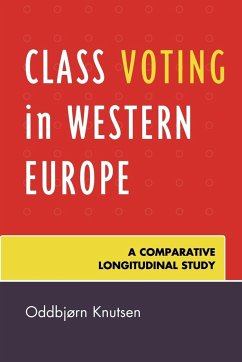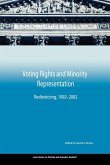- Broschiertes Buch
- Merkliste
- Auf die Merkliste
- Bewerten Bewerten
- Teilen
- Produkt teilen
- Produkterinnerung
- Produkterinnerung
Class Voting in Western Europe outlines the theories of changes in class voting and provides an empirical analysis of class voting. Knutsen's thorough study will provide a new, straightforward understanding of social class and party choice to anyone interested in the complex relationship between modern society and politics.
Andere Kunden interessierten sich auch für
![Voting Rights and Minority Representation Voting Rights and Minority Representation]() Voting Rights and Minority Representation56,99 €
Voting Rights and Minority Representation56,99 €![From Open Secrets to Secret Voting From Open Secrets to Secret Voting]() Isabela MaresFrom Open Secrets to Secret Voting38,99 €
Isabela MaresFrom Open Secrets to Secret Voting38,99 €![The Structure of Political Competition in Western Europe The Structure of Political Competition in Western Europe]() The Structure of Political Competition in Western Europe77,99 €
The Structure of Political Competition in Western Europe77,99 €![Organizing Interests in Western Europe Organizing Interests in Western Europe]() Organizing Interests in Western Europe34,99 €
Organizing Interests in Western Europe34,99 €![Women and Politics in Western Europe Women and Politics in Western Europe]() Sylvia B BashevkinWomen and Politics in Western Europe70,99 €
Sylvia B BashevkinWomen and Politics in Western Europe70,99 €![Peace and Security in the Western Balkans Peace and Security in the Western Balkans]() Peace and Security in the Western Balkans67,99 €
Peace and Security in the Western Balkans67,99 €![Parliaments and Citizens in Western Europe Parliaments and Citizens in Western Europe]() Philip Norton (ed.)Parliaments and Citizens in Western Europe66,99 €
Philip Norton (ed.)Parliaments and Citizens in Western Europe66,99 €-
-
-
Class Voting in Western Europe outlines the theories of changes in class voting and provides an empirical analysis of class voting. Knutsen's thorough study will provide a new, straightforward understanding of social class and party choice to anyone interested in the complex relationship between modern society and politics.
Hinweis: Dieser Artikel kann nur an eine deutsche Lieferadresse ausgeliefert werden.
Hinweis: Dieser Artikel kann nur an eine deutsche Lieferadresse ausgeliefert werden.
Produktdetails
- Produktdetails
- Verlag: Lexington Books
- Seitenzahl: 244
- Erscheinungstermin: 21. Mai 2008
- Englisch
- Abmessung: 229mm x 152mm x 15mm
- Gewicht: 402g
- ISBN-13: 9780739129265
- ISBN-10: 0739129260
- Artikelnr.: 24546409
- Herstellerkennzeichnung
- Produktsicherheitsverantwortliche/r
- Europaallee 1
- 36244 Bad Hersfeld
- gpsr@libri.de
- Verlag: Lexington Books
- Seitenzahl: 244
- Erscheinungstermin: 21. Mai 2008
- Englisch
- Abmessung: 229mm x 152mm x 15mm
- Gewicht: 402g
- ISBN-13: 9780739129265
- ISBN-10: 0739129260
- Artikelnr.: 24546409
- Herstellerkennzeichnung
- Produktsicherheitsverantwortliche/r
- Europaallee 1
- 36244 Bad Hersfeld
- gpsr@libri.de
By Knutsen, Oddbjørn
Part 1 Part I: Theories and explanations for the decline in class voting
Chapter 2 Introduction Chapter 3 Social mobility Chapter 4 New social
divisions Chapter 5 Cognitive mobilization Chapter 6 The embourgeoisement
thesis Chapter 7 New Politics and middle class radicalism Chapter 8 The
debate about the political orientations of the service class Chapter 9
Party strategy, class appeal and changes in class structure Chapter 10 The
debate about the persistence or decline of class voting Part 11 Part II:
Class schema and operationalizations of social class Chapter 12 The
Erikson/Goldthorpe class schema Chapter 13 Operationalization of social
class: Occupation variables and construction of class variables in the
Eurobarometer data set. Part 14 Part III: Party systems, party families and
the party choice variable Chapter 15 Voting intention in the Eurobarometer
data Chapter 16 Party families and trends in support for the various
parties Chapter 17 Socialist/non-socialist party choice Part 18 Part IV:
Total class voting Chapter 19 Introduction Chapter 20 The strength of the
correlation Chapter 21 Statistical measures for tapping class voting
Chapter 22 Party families Chapter 23 Patterns within countries and changes
over time Chapter 24 Conclusions: Main patterns regarding changes over time
Part 25 Part V: Overall left-right (socialist/non-socialist) class voting
Chapter 26 Overall left-right voting for the whole period Chapter 27 Trends
in overall left-right class voting Part 28 Part VI: Traditional class
voting: Socialist/non-socialist party choiceand the two class variables
Chapter 29 Introduction: The relevance of traditional class voting in
advances industrial democracies and how it is measured Chapter 30 Empirical
analysis: Trends in traditional class voting Chapter 31 Class voting
according to a different treatment of the routinenon-manual group Part 32
Part VII: Explanations for changes in class voting Chapter 33 Introduction
Chapter 34 Hypotheses about trends and cross-national patterns of class
voting Chapter 35 Explaining trends in class voting within countries over
time Chapter 36 Explaining the cross-national variations in level of class
voting Chapter 37 Pooled time-series cross sectional analyses Chapter 38
Part VIII: Conclusions Part 39 Part IX: Literature
Chapter 2 Introduction Chapter 3 Social mobility Chapter 4 New social
divisions Chapter 5 Cognitive mobilization Chapter 6 The embourgeoisement
thesis Chapter 7 New Politics and middle class radicalism Chapter 8 The
debate about the political orientations of the service class Chapter 9
Party strategy, class appeal and changes in class structure Chapter 10 The
debate about the persistence or decline of class voting Part 11 Part II:
Class schema and operationalizations of social class Chapter 12 The
Erikson/Goldthorpe class schema Chapter 13 Operationalization of social
class: Occupation variables and construction of class variables in the
Eurobarometer data set. Part 14 Part III: Party systems, party families and
the party choice variable Chapter 15 Voting intention in the Eurobarometer
data Chapter 16 Party families and trends in support for the various
parties Chapter 17 Socialist/non-socialist party choice Part 18 Part IV:
Total class voting Chapter 19 Introduction Chapter 20 The strength of the
correlation Chapter 21 Statistical measures for tapping class voting
Chapter 22 Party families Chapter 23 Patterns within countries and changes
over time Chapter 24 Conclusions: Main patterns regarding changes over time
Part 25 Part V: Overall left-right (socialist/non-socialist) class voting
Chapter 26 Overall left-right voting for the whole period Chapter 27 Trends
in overall left-right class voting Part 28 Part VI: Traditional class
voting: Socialist/non-socialist party choiceand the two class variables
Chapter 29 Introduction: The relevance of traditional class voting in
advances industrial democracies and how it is measured Chapter 30 Empirical
analysis: Trends in traditional class voting Chapter 31 Class voting
according to a different treatment of the routinenon-manual group Part 32
Part VII: Explanations for changes in class voting Chapter 33 Introduction
Chapter 34 Hypotheses about trends and cross-national patterns of class
voting Chapter 35 Explaining trends in class voting within countries over
time Chapter 36 Explaining the cross-national variations in level of class
voting Chapter 37 Pooled time-series cross sectional analyses Chapter 38
Part VIII: Conclusions Part 39 Part IX: Literature
Part 1 Part I: Theories and explanations for the decline in class voting
Chapter 2 Introduction Chapter 3 Social mobility Chapter 4 New social
divisions Chapter 5 Cognitive mobilization Chapter 6 The embourgeoisement
thesis Chapter 7 New Politics and middle class radicalism Chapter 8 The
debate about the political orientations of the service class Chapter 9
Party strategy, class appeal and changes in class structure Chapter 10 The
debate about the persistence or decline of class voting Part 11 Part II:
Class schema and operationalizations of social class Chapter 12 The
Erikson/Goldthorpe class schema Chapter 13 Operationalization of social
class: Occupation variables and construction of class variables in the
Eurobarometer data set. Part 14 Part III: Party systems, party families and
the party choice variable Chapter 15 Voting intention in the Eurobarometer
data Chapter 16 Party families and trends in support for the various
parties Chapter 17 Socialist/non-socialist party choice Part 18 Part IV:
Total class voting Chapter 19 Introduction Chapter 20 The strength of the
correlation Chapter 21 Statistical measures for tapping class voting
Chapter 22 Party families Chapter 23 Patterns within countries and changes
over time Chapter 24 Conclusions: Main patterns regarding changes over time
Part 25 Part V: Overall left-right (socialist/non-socialist) class voting
Chapter 26 Overall left-right voting for the whole period Chapter 27 Trends
in overall left-right class voting Part 28 Part VI: Traditional class
voting: Socialist/non-socialist party choiceand the two class variables
Chapter 29 Introduction: The relevance of traditional class voting in
advances industrial democracies and how it is measured Chapter 30 Empirical
analysis: Trends in traditional class voting Chapter 31 Class voting
according to a different treatment of the routinenon-manual group Part 32
Part VII: Explanations for changes in class voting Chapter 33 Introduction
Chapter 34 Hypotheses about trends and cross-national patterns of class
voting Chapter 35 Explaining trends in class voting within countries over
time Chapter 36 Explaining the cross-national variations in level of class
voting Chapter 37 Pooled time-series cross sectional analyses Chapter 38
Part VIII: Conclusions Part 39 Part IX: Literature
Chapter 2 Introduction Chapter 3 Social mobility Chapter 4 New social
divisions Chapter 5 Cognitive mobilization Chapter 6 The embourgeoisement
thesis Chapter 7 New Politics and middle class radicalism Chapter 8 The
debate about the political orientations of the service class Chapter 9
Party strategy, class appeal and changes in class structure Chapter 10 The
debate about the persistence or decline of class voting Part 11 Part II:
Class schema and operationalizations of social class Chapter 12 The
Erikson/Goldthorpe class schema Chapter 13 Operationalization of social
class: Occupation variables and construction of class variables in the
Eurobarometer data set. Part 14 Part III: Party systems, party families and
the party choice variable Chapter 15 Voting intention in the Eurobarometer
data Chapter 16 Party families and trends in support for the various
parties Chapter 17 Socialist/non-socialist party choice Part 18 Part IV:
Total class voting Chapter 19 Introduction Chapter 20 The strength of the
correlation Chapter 21 Statistical measures for tapping class voting
Chapter 22 Party families Chapter 23 Patterns within countries and changes
over time Chapter 24 Conclusions: Main patterns regarding changes over time
Part 25 Part V: Overall left-right (socialist/non-socialist) class voting
Chapter 26 Overall left-right voting for the whole period Chapter 27 Trends
in overall left-right class voting Part 28 Part VI: Traditional class
voting: Socialist/non-socialist party choiceand the two class variables
Chapter 29 Introduction: The relevance of traditional class voting in
advances industrial democracies and how it is measured Chapter 30 Empirical
analysis: Trends in traditional class voting Chapter 31 Class voting
according to a different treatment of the routinenon-manual group Part 32
Part VII: Explanations for changes in class voting Chapter 33 Introduction
Chapter 34 Hypotheses about trends and cross-national patterns of class
voting Chapter 35 Explaining trends in class voting within countries over
time Chapter 36 Explaining the cross-national variations in level of class
voting Chapter 37 Pooled time-series cross sectional analyses Chapter 38
Part VIII: Conclusions Part 39 Part IX: Literature








